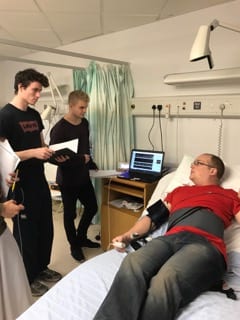Thinking clinical at the Learning Hospital
By rmapapg, on 3 December 2016
By Julian Henty
Clinical Engineering knowledge and skills were put to the test recently during a visit to UCLH’s Learning Hospital. Second year Biomedical Engineering students were given the chance to test various medical devices, such as ventilators, bedside monitors and suction machines, examine the workings of an in-house automated blood pressure machine, and observe vital signs measurement from a real ‘patient’ using a virtual bedside monitor.
Despite making good use of the department’s electronics lab for experimentation with transducers, software driven data acquisition, and aspects of electrical safety, the Clinical Engineering module fulfills its practical aims by providing a hands-on session with real hospital equipment and actual clinical measurements in a realistic clinical environment. The Learning Hospital has a ‘theatre’, complete with operating table and appropriate medical devices, and a ‘ward’ with two beds, nurses’ station and a medical gas supply.
The virtual non-invasive blood pressure (NIBP) device comprised a PC, control board and recycled components from a disassembled standard NIBP device. LabVIEW software measured the photoplethysmogram (PPG) amplitude distal to the cuff during inflation/deflation, which provided feedback to control the air pump and release valve. The software had an illustrative screen showing each step in the process of taking a real measurement. Safety aspects of NIBP measurement could also be demonstrated.
The virtual bedside monitor displayed real-time graphs of the ECG, PPG, NIBP and chest movement while the ‘patient’ lay on a bed. LabVIEW software demonstrated how heart rate may be extracted from the ECG, PPG, or NIBP measurements, and respiratory rate from the ECG or chest movement. The software could also manipulate the ECG to demonstrate both noise and other lead measurements, and simulation of low amplitude due to pericardial/pleural effusion, pneumothorax, obesity or loss of viable myocardium.
With thanks to Dimitros Airantiz, Billy Dennis and Paul Burke
 Close
Close


